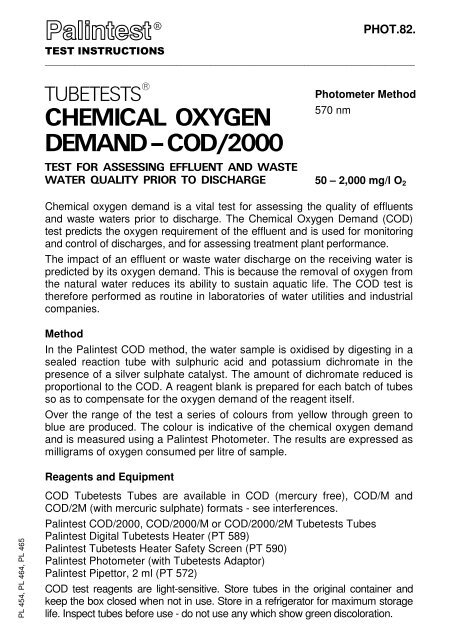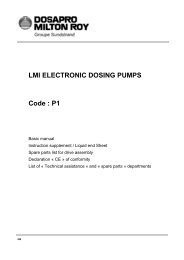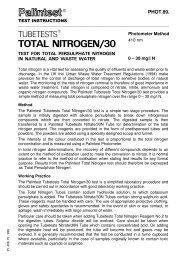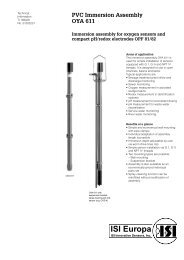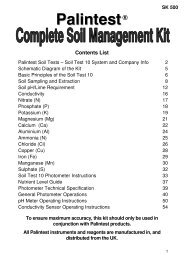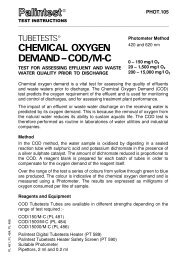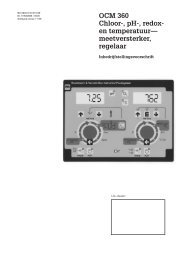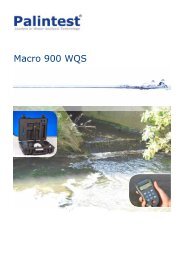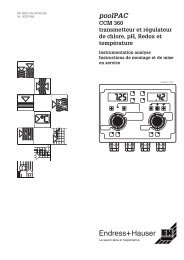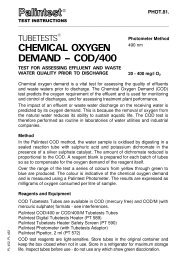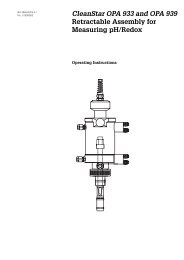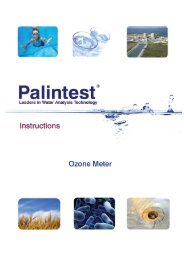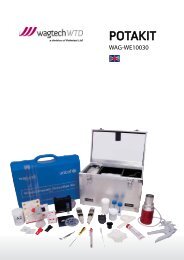CHEMICAL OXYGEN DEMANDâCOD/2000 - Palintest
CHEMICAL OXYGEN DEMANDâCOD/2000 - Palintest
CHEMICAL OXYGEN DEMANDâCOD/2000 - Palintest
You also want an ePaper? Increase the reach of your titles
YUMPU automatically turns print PDFs into web optimized ePapers that Google loves.
®PHOT.82.TEST INSTRUCTIONS_______________________________________________________________________________________TUBETESTS ®<strong>CHEMICAL</strong> <strong>OXYGEN</strong>DEMAND – COD/<strong>2000</strong>TEST FOR ASSESSING EFFLUENT AND WASTEWATER QUALITY PRIOR TO DISCHARGEPhotometer Method570 nm50 – 2,000 mg/l O 2Chemical oxygen demand is a vital test for assessing the quality of effluentsand waste waters prior to discharge. The Chemical Oxygen Demand (COD)test predicts the oxygen requirement of the effluent and is used for monitoringand control of discharges, and for assessing treatment plant performance.The impact of an effluent or waste water discharge on the receiving water ispredicted by its oxygen demand. This is because the removal of oxygen fromthe natural water reduces its ability to sustain aquatic life. The COD test istherefore performed as routine in laboratories of water utilities and industrialcompanies.MethodIn the <strong>Palintest</strong> COD method, the water sample is oxidised by digesting in asealed reaction tube with sulphuric acid and potassium dichromate in thepresence of a silver sulphate catalyst. The amount of dichromate reduced isproportional to the COD. A reagent blank is prepared for each batch of tubesso as to compensate for the oxygen demand of the reagent itself.Over the range of the test a series of colours from yellow through green toblue are produced. The colour is indicative of the chemical oxygen demandand is measured using a <strong>Palintest</strong> Photometer. The results are expressed asmilligrams of oxygen consumed per litre of sample.Reagents and EquipmentPL 454, PL 464, PL 465COD Tubetests Tubes are available in COD (mercury free), COD/M andCOD/2M (with mercuric sulphate) formats - see interferences.<strong>Palintest</strong> COD/<strong>2000</strong>, COD/<strong>2000</strong>/M or COD/<strong>2000</strong>/2M Tubetests Tubes<strong>Palintest</strong> Digital Tubetests Heater (PT 589)<strong>Palintest</strong> Tubetests Heater Safety Screen (PT 590)<strong>Palintest</strong> Photometer (with Tubetests Adaptor)<strong>Palintest</strong> Pipettor, 2 ml (PT 572)COD test reagents are light-sensitive. Store tubes in the original container andkeep the box closed when not in use. Store in a refrigerator for maximum storagelife. Inspect tubes before use - do not use any which show green discoloration.
Working PracticeThe <strong>Palintest</strong> COD test is a simplified laboratory procedure and should becarried out in accordance with good laboratory working practice. The reagenttubes contain 84% sulphuric acid and must be handled with care. The use ofappropriate protective clothing, gloves and safety spectacles is recommended.In the event of skin or eye contact, or spillage, wash immediately with largeamounts of water.Particular care should be taken when opening the reagent tubes to add thewater sample as heat will be produced and gases may be evolved. Samplescontaining cyanide or sulphide will release toxic fumes and for such samplesthe test must always be carried out in a fume cupboard. It is generallyrecommended that the test be conducted in a fume cupboard where available,particularly when using the COD/M format.Reagent tubes should not be opened whilst hot as pressure build-up maycause acid spillage. Do not open tubes after sample digestion.Test CalibrationTransmittance-display photometer - use calibration chartDirect-reading photometer - select program Phot 82 (Photometer 7000)or TTest 4 (Tubetests Photometer)The photometer is used in conjunction with a special Tubetests Adaptor(PT 586) which fits into the test chamber. The adaptor must be located withthe position mark facing towards the user and must be pushed fully hometo the bottom of the test chamber.Reagent BlankIn this test a reagent blank is used instead of the usual water blank referred toin the general photometer operating instructions. The reagent blank isprepared by adding deionised or distilled water to the reagent tube (see TestProcedure, Step 4) and then digesting the tube in the same manner as for thewater sample.It is not necessary to prepare a reagent blank each time the test is carried out.The reagent blank tube may be prepared weekly and used repeatedly with allsamples prepared from the same batch of reagent tubes. The reagent blankshould be stored in the dark, for example in the original packaging between use.Sample PreparationEffluents and waste water samples may contain undissolved or particulatematerial. Such samples may be homogenised in a blender prior to the test inorder to improve accuracy and reproducibility.
Test Procedure1 Turn on Tubetests heater, set the control to 150°C and place the safetyshield in position. Allow the heater to heat up to temperature (seeTubetests Heater).2 Prepare the SAMPLE TUBE as follows. Shake tube vigorously to suspendall sediment. Remove the cap of the COD Tubetests tube and add 2 ml ofsample using a <strong>Palintest</strong> pipettor disposable tip dispenser or a standardlaboratory pipette.3 Replace the cap tightly and invert tube gently to mix contents. The tubewill become hot on mixing. Ensure all of the precipitate is suspendedbefore proceeding. Label the tube using the labels provided in the reagentpack and place the tube in the Tubetests heater. Ensure the safety screenis in position.4 Prepare a REAGENT BLANK by repeating steps 2 and 3 using 2 ml ofdeionised or distilled water in place of the sample. This stage may beomitted if a suitable reagent blank tube is already available (see ReagentBlank).5 Digest the tubes for two hours then turn off the heater unless it is requiredfor further tests.6 Carefully remove each tube, invert gently to mix and then transfer to a testtube rack.7 Allow the tubes to cool to room temperature.8 Select wavelength 570 nm on Photometer.9 Take the photometer reading (see photometer instructions).10 Consult COD/<strong>2000</strong> calibration chart (Transmittance-display photometer only).COD/<strong>2000</strong> mg/l O 2 570 nm%T 9 8 7 6 5 4 3 2 1 090 10 20 35 45 60 70 85 100 110 12580 140 155 170 185 200 215 230 245 260 27570 290 305 320 340 355 370 390 405 425 44060 460 475 495 515 535 550 570 590 610 63050 650 675 695 720 740 760 785 810 835 86040 885 910 940 970 1000 1030 1060 1090 1120 115030 1185 1220 1260 1295 1330 1370 1410 1450 1490 153520 1585 1635 1680 1730 1790 1850 1910 <strong>2000</strong> - -
InterferencesChloride is the main potential interference in the COD test. High chloridelevels may result in an apparent high COD result. The <strong>Palintest</strong> COD/<strong>2000</strong>test will not be significantly affected by chloride levels up to 100 mg/l. Samplescontaining above this level should be diluted so as to reduce the concentrationto 100 mg/l or below and the test carried out on the diluted sample.If sample dilution is not possible then it may be necessary to suppress chlorideinterference. The method most commonly prescribed in standard analyticalmethods is the addition of mercuric sulphate to the reagent system. In the<strong>Palintest</strong> COD/<strong>2000</strong>/M test 0.04g of mercuric sulphate is provided in each tubeof reagent and will suppress interference from up to 2,000 mg/l chloride in thesample. In the <strong>Palintest</strong> COD/<strong>2000</strong>/2M test 0.08g of mercuric sulphate isprovided and will suppress interference from up to 4,000 mg/l chloride insamples containing from 50 to 2,000 mg/l COD.DisposalThe used COD Tubetests tubes contain strong sulphuric acid and otherchemical reagents and care must therefore be exercised in their disposal. Thetube contents should be disposed of in accordance with the laid down disposalprocedures of the laboratory of use. Used COD/<strong>2000</strong> tubes may, subject toconsent limits, be decanted into running water, or into a sink of water, andthen run to waste. Used COD/<strong>2000</strong>/M tubes must always be treated using aproper waste disposal system. A COD tube disposal service is availablethrough <strong>Palintest</strong> Ltd (UK only). The tubes must not be re-used as they aredesigned for single use only.Tubetests HeatersThe <strong>Palintest</strong> Tubetests heaters are dedicated heaters for use with the CODTubetests system. They comprise an electronically controlled dry bath whichheats aluminium test tube blocks. The heaters are designed to provide thecorrect digesting and refluxing conditions necessary for the COD test. Theyprovide the correct digestion temperature of 150°C ± 3°C in the reagent tubes.The <strong>Palintest</strong> Digital Tubetests Heater (PT 589) is a 12 tube heater with anintegral safety screen. The heater features a digital display for the operatingand set temperatures.To use the digital heater for the COD test, set the temperature on the digitaldisplay to 150°C. It is not necessary to use a thermometer with this heater -the operating temperature is shown on the digital display. The display takesinto account thermal lag between the block and the heater tubes.On no account must heaters be set at a higher temperature than that specifiedas this may cause a hazard through pressure build-up in the COD tubes.___________________________V3 - 04/08


